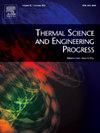Influence of obstacle blockage on flame propagation, overpressure and local temperature of vapor deflagration in narrow ship channel-like space
IF 5.1
3区 工程技术
Q2 ENERGY & FUELS
引用次数: 0
Abstract
A special study mainly concerning the influence of blockage ratio on flame propagation, overpressure and local temperature distribution characteristic of combustible vapor deflagration in narrow channel of ship was conducted. Rectangular obstacles with 30∼55 % blockage ratio were tested. The flame propagation, overpressure and local temperature were recorded and analyzed. Results indicated that obstacle edges have obvious shear action to flame front, which the front structure and surface area would be obviously stretched. The presence of obstacles could enhance the turbulence intensity of local fluid and induce more turbulent flame, leading to a significantly increased propagation speed. In current tests, flame propagation speed increased firstly and then decreased with the blockage ratio, and the maximum flame speed could reach 97.5 m/s. Overpressure also performs a non-monotonous variation, which could be attributed to the fact that obstacles can not only positively stimulate the deflagration by enhancing local turbulence intensity, but also have an obstructing effect on the propagation of flame and pressure wave. This means, there is a critical blockage ratio, at which the overpressure is maximized, and this critical value is found to be around 40 % in current experimental conditions. Meanwhile, the propagation of deflagration overpressure and flame involved the obvious coupling effect, and the overpressure and flame reached peaks almost simultaneously. This work is expected to provide some basic references for the emergency disposal of combustible liquid vapor deflagration accidents.
障碍物堵塞对狭窄船道空间蒸汽爆燃火焰传播、超压和局部温度的影响
针对船舶窄通道可燃蒸汽爆燃过程中,堵塞比对火焰传播、超压及局部温度分布特性的影响进行了专门研究。测试了阻塞率为30 ~ 55%的矩形障碍物。记录并分析了火焰传播、超压和局部温度。结果表明:障碍物边缘对火焰锋面有明显的剪切作用,使火焰锋面结构和表面积受到明显拉伸;障碍物的存在可以增强局部流体的湍流强度,诱导湍流火焰,导致传播速度显著提高。在目前的试验中,火焰的传播速度随堵塞比的增大先增大后减小,最大火焰速度可达97.5 m/s。超压也表现出非单调的变化,这可能是由于障碍物不仅可以通过增强局部湍流强度来积极刺激爆燃,而且对火焰和压力波的传播也有阻碍作用。这意味着存在一个临界堵塞比,在这个临界堵塞比下,超压达到最大值,在目前的实验条件下,这个临界值在40%左右。同时,爆燃超压与火焰的传播存在明显的耦合效应,超压与火焰几乎同时达到峰值。期望为可燃液体蒸汽爆燃事故的应急处置提供一定的基础参考。
本文章由计算机程序翻译,如有差异,请以英文原文为准。
求助全文
约1分钟内获得全文
求助全文
来源期刊

Thermal Science and Engineering Progress
Chemical Engineering-Fluid Flow and Transfer Processes
CiteScore
7.20
自引率
10.40%
发文量
327
审稿时长
41 days
期刊介绍:
Thermal Science and Engineering Progress (TSEP) publishes original, high-quality research articles that span activities ranging from fundamental scientific research and discussion of the more controversial thermodynamic theories, to developments in thermal engineering that are in many instances examples of the way scientists and engineers are addressing the challenges facing a growing population – smart cities and global warming – maximising thermodynamic efficiencies and minimising all heat losses. It is intended that these will be of current relevance and interest to industry, academia and other practitioners. It is evident that many specialised journals in thermal and, to some extent, in fluid disciplines tend to focus on topics that can be classified as fundamental in nature, or are ‘applied’ and near-market. Thermal Science and Engineering Progress will bridge the gap between these two areas, allowing authors to make an easy choice, should they or a journal editor feel that their papers are ‘out of scope’ when considering other journals. The range of topics covered by Thermal Science and Engineering Progress addresses the rapid rate of development being made in thermal transfer processes as they affect traditional fields, and important growth in the topical research areas of aerospace, thermal biological and medical systems, electronics and nano-technologies, renewable energy systems, food production (including agriculture), and the need to minimise man-made thermal impacts on climate change. Review articles on appropriate topics for TSEP are encouraged, although until TSEP is fully established, these will be limited in number. Before submitting such articles, please contact one of the Editors, or a member of the Editorial Advisory Board with an outline of your proposal and your expertise in the area of your review.
 求助内容:
求助内容: 应助结果提醒方式:
应助结果提醒方式:


